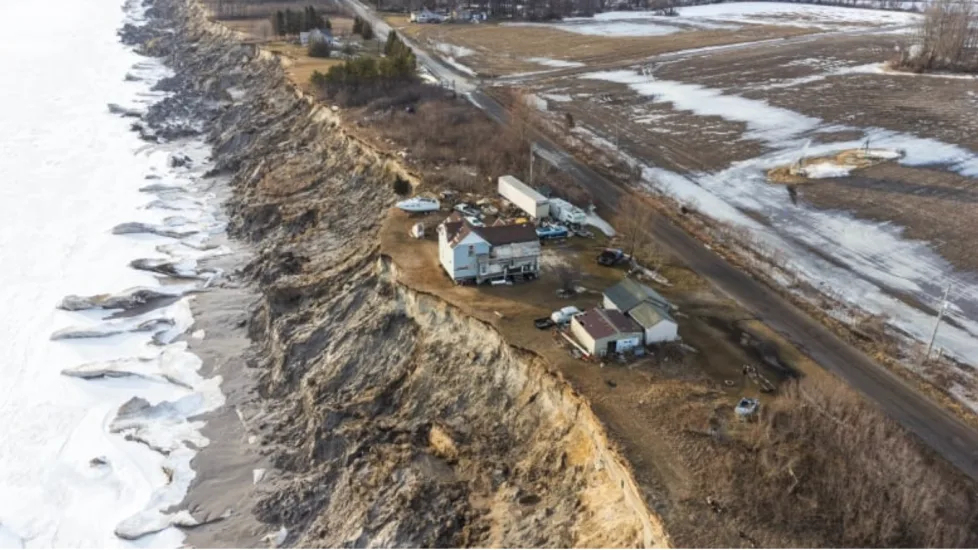
Lake Erie erosion is putting junk into the lake, photographer says
Since 2019, David Piano has used his considerable photography skills to document soil erosion along Lake Erie's north shore.
Focusing on a stretch of almost 200 kilometres of lakefront from Port Burwell to Wheatley, he's captured images of crumbling cliffs and cottages swallowed by lake water eating away at the shore.
Lake Erie's soil erosion problem isn't new. For years, property owners have been lobbying governments and spending thousands to combat erosion that threatens buildings, many of them seasonal cottages that have been in families for decades.

Through the use of a drone, this image by photographer David Piano shows items on a rural property in danger of falling into the lake due to ongoing soil erosion. (David Piano/Twitter)
But this week, Piano felt compelled to tweet about what he sees as an accelerated pace of erosion this winter. He said some properties that were on solid dirt when he photographed them in November have since ceded 10 metres or more to the water in the space of a few months.
"We're getting these huge pieces of the bluff that are breaking away," Piano told CBC News. "There's basically these mud waterfalls that are coming out from under the bluff edge and eroding away from underneath. You keep getting these pieces that break off, and that process seems to be accelerating."
Piano, who is also a storm watcher, uses a drone camera to capture his images. The drone allows him to swing the camera out and high above the water and shoot down at properties where the erosion is happening.
One new and concerning aspect of the erosion: It's pulling junk from affected properties into the lake.
He's seen items left outside on the properties — including tires, scrap metal, propane tanks and vehicles — tumble toward the lake as the ground beneath them erodes.
"We're looking at huge toxins," he said. "By the time March and April rolls around, that's going to be in the waters of Lake Erie."
Municipalities with Lake Erie shoreline should be calling on property owners to pull items away from the edge of the bluffs so it doesn't end up in the lake, he said.
CBC News reached out to the Lower Thames Valley Conservation Authority (LVTCA) for comment but didn't hear back on Thursday.
That stretch of shoreline is governed by six small municipalities.
Duncan McPhail is the mayor of West Elgin, which includes the lakeshore community of Port Glasgow.
WATCH BELOW: THE FROZEN HOUSES ALONG LAKE ERIE THAT LOOKED LIKE A SCENE FROM A FAIRYTALE OR NIGHTMARE
While he's well aware of the challenges caused by shoreline erosion, he said it's the first he's heard of it causing junk to fall into the lake. He's open to looking into the problem, but said when it comes to shoreline issues, the LVTCA is the body with jurisdiction.
It would be difficult for a small municipality with limited resources to police what's happening on private properties, where the shoreline is often high above the beach and distant from the road, McPhail said.
In a statement, the Municipality of Dutton Dunwich said it has amended its Official Plan in response to shore erosion — for example, adding new shoreline setbacks for buildings — in response to advice from the province and the conservation authority.
In the meantime, Piano will continue to document the shoreline erosion with his photography. He plans to eventually package his work in a video documentary titled On The Brink. He's hoping it will expose a wider audience to a problem he calls "an environmental crisis."
He expects the erosion will continue to get worse with the arrival of spring, when rains and warmer weather will further soften the soil.
"I'm sure the erosion is going to reach an even more alarming crescendo come March and April."
WATCH BELOW: GHOSTLY ICE FIGURES SPOTTED GUARDING THE SHORES OF LAKE ERIE
This article, written by Andrew Lupton, was originally published for CBC News.